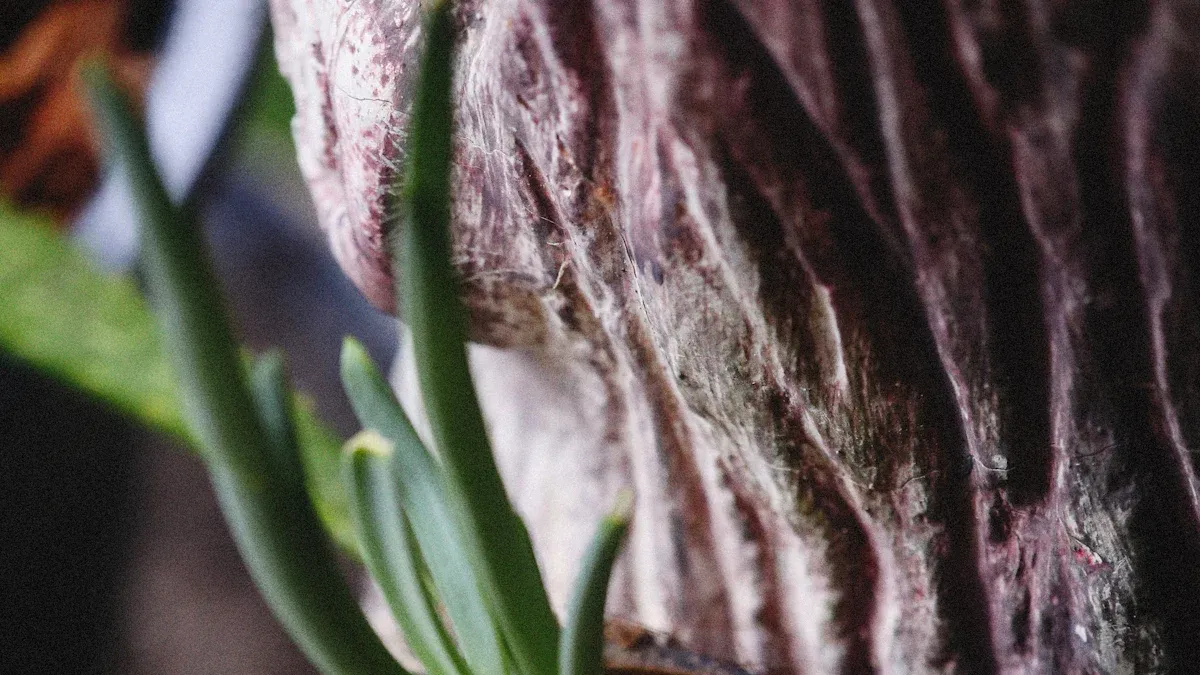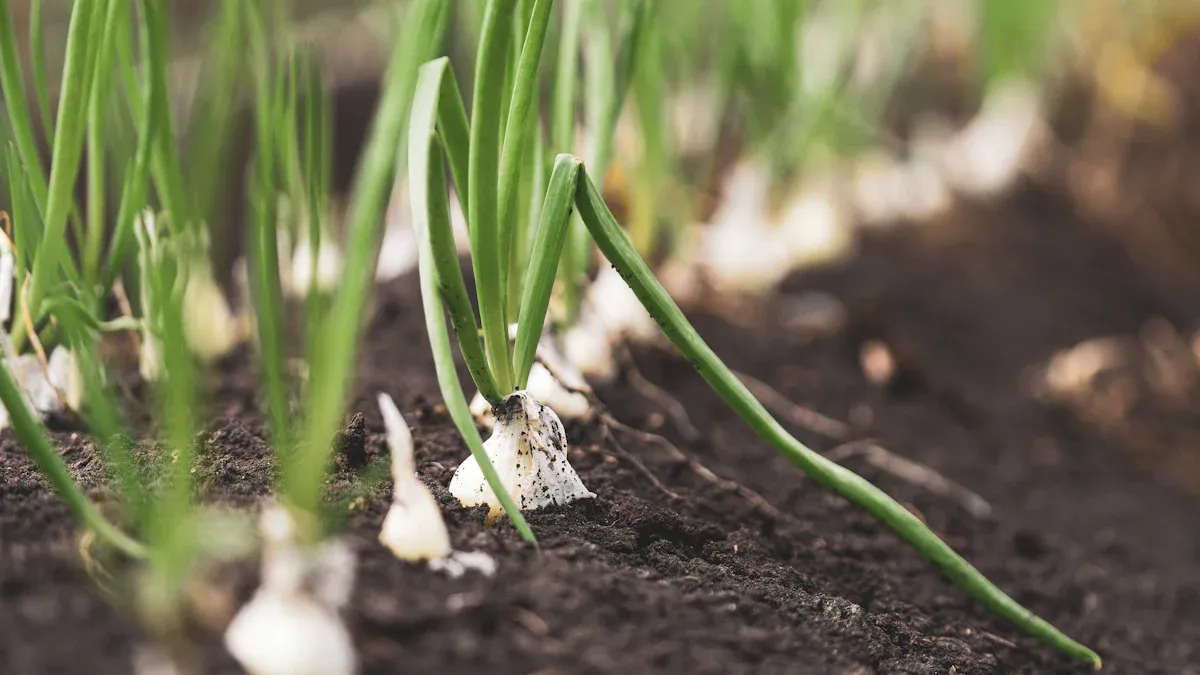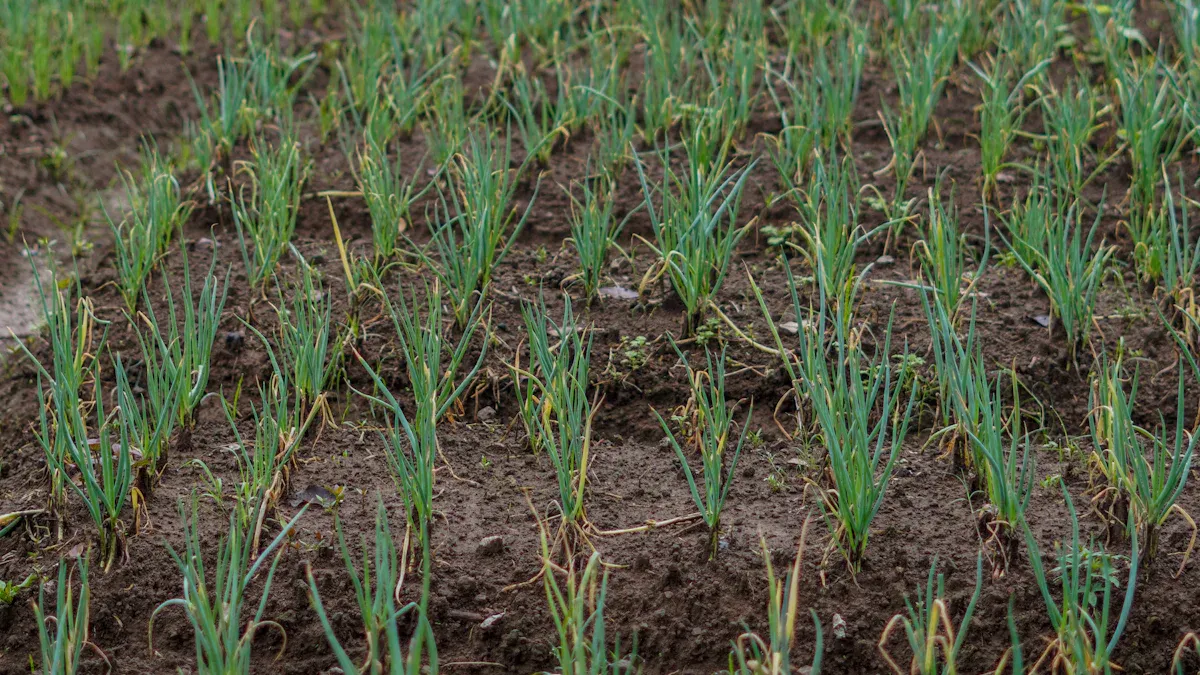
Did you know that global onion production reaches about 105 billion pounds each year? That’s a lot of onions! Whether you’re growing them in your backyard or just curious about gardening, understanding onion-growing tips can help you cultivate a bountiful harvest.
Key Takeaways
Choose between onion sets and seeds based on your experience. Onion sets are easier for beginners and yield quicker results.
Plant onions at the right time. In temperate climates, aim for November to December for transplants to ensure a successful harvest.
Prepare nutrient-rich, well-drained soil with a pH of 6.0 to 7.5. This supports healthy root development and boosts onion growth.
Planting

When it comes to planting onions, you have two main options: onion sets and seeds. Onion sets are small, immature bulbs that you can plant directly into the ground. They’re great for beginners because they’re easy to handle and typically produce a quicker harvest. On the other hand, onion seeds require a bit more patience. You’ll need to start them indoors or in a controlled environment before transferring them outside. Both methods have their benefits, so choose what works best for you!
Onion Sets vs. Seeds
Onion Sets:
Quick to grow.
Less susceptible to pests.
Ideal for beginners.
Onion Seeds:
Greater variety of types.
Longer growing season.
Requires more care.
Best Time to Plant
Timing is crucial for a successful onion harvest. In temperate climates, you should aim to plant your onions during specific months. Here’s a quick guide:
Transplants: November to December.
Early Varieties: Before the end of December.
Late Planting: Avoid this, as it can lead to lower yields and smaller bulbs.
Soil temperature also plays a significant role in germination. Onions germinate best when soil temperatures are above 45°F. The optimum temperature for seed germination is around 75°F. Here’s a quick look at how temperature affects onion growth:
Temperature Range (°F) | Effect on Onion Growth |
|---|---|
Above 45 | Germination can occur |
75 | Optimum temperature for seed germination |
65 to 68 | Optimum temperature for foliar growth |
Below 28 | Potentially lethal to seedlings |
Above 90 | Decline in growth rate and smaller bulbs |
By following these onion-growing tips, you’ll set yourself up for a successful planting season!
Soil Preparation

Preparing the right soil is crucial for growing healthy onions. You want to create an environment that supports robust root development. Healthy soil allows your onion plants to develop a larger and more aggressive root mass. This strong root system leads to healthier stalks and leaves, boosting productivity and resilience against tough conditions.
Ideal Soil Type
Onions thrive in well-drained, loamy soil. Aim for a soil texture that is rich in organic matter. Here are some key points to consider:
Onion roots primarily grow in the top 18 inches of soil, so ensure this layer is nutrient-rich.
Conduct a soil test in the fall to determine what fertilizers you might need for optimal growth.
Understanding your specific crop needs helps you select the right fertilizer type and application rates.
Soil pH and Nutrients
The ideal soil pH for onions ranges from 6.0 to 7.5, with 6.8 being optimal for the best growth. Maintaining this pH level ensures that your onions can absorb essential nutrients effectively. Here’s a quick table of critical nutrients and their deficiency symptoms:
Nutrient | Deficiency Symptoms |
|---|---|
Boron | Chlorosis, Deformation |
Calcium | Growth retardation, Necrosis |
Copper | Paling, Discolouration |
Iron | Dark Green Color, Die off |
Magnesium | Growth retardation, Deformation |
Phosphorus | Discolouration, Growth retardation |
Sulfur | Chlorosis, Dark Green Color |
Zinc | Deformation, Necrosis |
By ensuring your soil has the right texture, pH, and nutrients, you set the stage for a successful onion-growing experience.
Care Tips
Taking care of your onions is crucial for a successful harvest. Here are some essential tips to help you nurture your onion plants throughout their growing season.
Watering Techniques
Watering your onions correctly can make a significant difference in their growth. Onions typically require about 3 inches of water per week. This amount is crucial for their development, especially during the yield formation period. Here’s a breakdown of water requirements based on different growth stages:
Growth Stage | Crop Coefficient (kc) | Water Requirement (mm) |
|---|---|---|
Initial Stage (15-20 days) | 0.4 – 0.6 | 350 – 550 |
Crop Development (25-35 days) | 0.7 – 0.8 | 350 – 550 |
Mid-Season (25-45 days) | 0.95 – 1.1 | 350 – 550 |
Late-Season (35-45 days) | 0.85 – 0.9 | 350 – 550 |
At Harvest | 0.75 – 0.85 | 350 – 550 |
Be mindful of the signs of overwatering and underwatering. Here are some symptoms to watch for:
Signs of Overwatering:
Yellowing leaves that appear unhealthy.
Risk of onions rotting in wet soil.
Development of root rot or fungal infections.
Signs of Underwatering:
Wilting leaves that appear dried out.
Cracked soil around the plants.
Insufficient moisture leading to smaller and less flavorful bulbs.
Fertilizing Onions
Fertilizing your onions properly is key to promoting healthy growth. Different growth stages require different types of fertilizers. Here’s a quick guide:
Germination (0-4 weeks): Maintain moisture for steady growth.
Vegetative Growth (1-3 months): Provide nitrogen for leaf growth.
Bulbing (2-4 months): Avoid high-nitrogen fertilizers to encourage proper bulbing.
Maturation (3-5 months): Reduce watering as bulbs mature.
Harvest and Curing (4-6 months): Cure bulbs in a dry area for storage longevity.
For effective fertilization, consider these options:
Composted Manure: Rich in nutrients and improves soil structure.
Fish Emulsion: High in nitrogen, promotes healthy foliage growth.
Bone Meal: Excellent source of phosphorus for strong root systems.
Balanced Organic Fertilizers: Provide a mix of nitrogen, phosphorus, and potassium for steady growth.
Onions thrive with a nitrogen-phosphorus-potassium ratio of approximately 160-80-140 lbs per acre. Adjust your fertilization strategy as your onions grow to ensure they receive the nutrients they need.
Sunlight Requirements
Onions love the sun! They need 6-8 hours of direct sunlight daily for optimal growth. Insufficient sunlight can impede their development. The size of the onion bulb depends on the number and size of the green leaves at the time of bulb maturity. Each leaf contributes to the formation of a ring in the bulb, so larger leaves lead to larger rings.
If your onions don’t get enough sunlight, you might notice slower growth and smaller bulbs. Ensure they’re planted in a location that receives plenty of sunlight, especially during their early growth stages.
By following these care tips, you’ll help your onions thrive and enjoy a bountiful harvest!
Mistakes to Avoid
Growing onions can be rewarding, but you might run into some common pitfalls. Here are three mistakes to watch out for and how to avoid them.
Overwatering
Overwatering is one of the biggest mistakes you can make. Too much water can lead to crop rot, both in the field and during storage. To prevent this, maintain soil moisture near field capacity. Here are some tips:
Use drip irrigation to keep moisture levels consistent.
Monitor soil moisture regularly. Sandy soils need more water than loamy soils.
Stop watering when the onion tops start to fall over. This helps the soil dry out before harvest.
Planting Too Close Together
Planting your onions too close can stunt their growth. When onions are overcrowded, they compete for nutrients and space, leading to smaller bulbs. Here’s a quick guide on spacing:
Planting Method | Recommended Spacing |
|---|---|
Onion Seeds | 2–3 inches apart |
Onion Sets | 3–4 inches apart (5–6 for larger bulbs) |
Onion Transplants | 4–6 inches apart (2–3 for small bulbs) |
Following these spacing guidelines will help ensure your onions grow to their full potential.
Ignoring Pests and Diseases
Don’t overlook pests and diseases! They can significantly impact your onion yield. Common issues include bulb mites and damping-off. Here’s how to manage them:
Use trap crops like marigolds to attract pests away from your onions.
Implement crop rotation to disrupt pest life cycles.
Maintain proper watering and soil fertility to strengthen your onion plants.
By avoiding these mistakes, you’ll set yourself up for a successful onion harvest! 🌱
Harvesting
Harvesting your onions at the right time is crucial for ensuring a good yield and quality. You want to make sure you catch them just as they reach maturity. So, how do you know when it’s time to pull them from the ground?
When to Harvest
Look for these signs to determine if your onions are ready for harvest:
Healthy Leaves: Initially, your onion plants will have green, upright leaves. As they mature, these leaves will start to yellow and bend over. This change signals that the growth cycle is ending.
Firm Bulbs: Mature bulbs should feel solid and firm. If they feel soft, they may not be ready yet.
Tops Falling Over: When about 85-90% of the tops have fallen over, it’s a good indication that your onions are nearing maturity.
Soft Neck: The area above the neck should feel soft, indicating that the transfer of carbohydrates has finished.
Last Leaf: The most recent leaf should be dry before you pull the onions. This helps prevent rot.
By paying attention to these indicators, you can ensure that your onions are harvested at their peak.
Proper Harvesting Methods
Once you’ve determined that your onions are ready, it’s time to harvest them properly to minimize damage. Here are some effective techniques:
Cut Water Supply: Stop watering your onions 1 to 2 weeks before harvesting. This helps the bulbs dry out and reduces the risk of rot.
Gently Lift Bulbs: Use your hands to pull the onions from the soil, grasping the stem just above the surface. Be careful not to yank them out, as this can damage the bulbs.
Shake Off Loose Soil: After lifting, gently shake off any loose dirt. However, keep some soil on the onions to help prevent moisture that can lead to rot.
Cure in the Field: Allow the bulbs to cure in the field for about 10 days. This helps them dry out and prepares them for storage.
Avoid Washing: Keep your onions dirty until you’re ready to store them. Washing can introduce moisture, which may lead to rot during curing.
Following these methods will help you harvest your onions effectively, ensuring they remain in good condition for storage.
Growing onions can be a rewarding experience when you follow the right tips. Remember to focus on sustainable practices like cover cropping and integrated pest management. Avoid common mistakes, such as overcrowding and poor soil quality. With these strategies, you’ll enjoy a bountiful onion harvest! 🌱
Key Practices | Benefits |
|---|---|
Sustainable Agriculture | Enhances crop productivity and protects the environment. |
Water Conservation | Minimizes water usage with efficient irrigation. |
Composting | Improves soil structure and recycles nutrients. |
FAQ
What type of onions should I grow for beginners?
You should start with onion sets. They’re easier to handle and provide quicker results than seeds.
How often should I water my onions?
Water your onions about once a week, ensuring they receive around 3 inches of moisture for healthy growth.
Can I grow onions in containers?
Yes! You can grow onions in containers. Just ensure they have enough depth and drainage for healthy root development. 🌱


